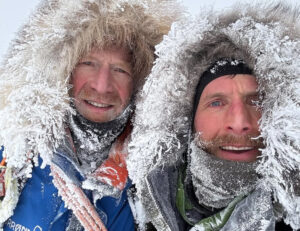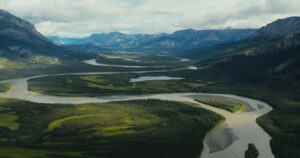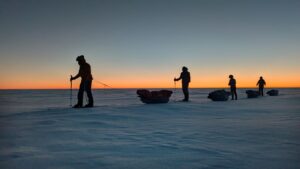Barneo is indefinitely closed but a few Arctic expeditions have managed to skirt war and COVID to get out on the ice.
Lena River
There’s still no word from British adventurer Charlie Walker. His last update suggested he was heading out along the frozen Lena River from Yakutsk, Russia, aiming to complete a 1,600km ski expedition. It has been almost a month since his last public post. He inauspiciously started the day that Russia invaded Ukraine.
Greenland to Baffin Island

The ice bridge area between Canada and Greenland on a previous year when it did not form: swiftly moving pack ice, porridge ice, open water. Photo: Jerry Kobalenko
The ice bridge between Greenland and Ellesmere Island has not formed. The loose pack ice means that Pascale Marceau, Scott Cocks, and Jayme Dittmar have had to change their plans. The team had been dogsledding toward the crossing point, aware that their 50km traverse to Canada was increasingly unlikely. However, that plan has also been undone.
“After several sections of impassable ice, sledge failure, exhaustion, and incoming weather conditions, the dog team had to turn back,” they wrote in a recent update.

The dog team had to turn back. Photo: Pascale Marceau/Scott Cocks/Jayme Dittmar
The trio has continued on foot with skis and pulks. They are pleased to be moving again but have encountered “seemingly endless” sastrugi and plenty of wind. Their next destination is the high-altitude part of the ice cap, which should be even windier and colder…
Ellesmere Island
In our last update, we reported that Kevin Vallely and Ray Zahab had aborted their 1,100km crossing of Ellesmere Island. Since then, Zahab and Vallely have explained what went wrong, and how they made the difficult decision to turn back. It seems that the snow was so soft that they reluctantly had to use their film crew’s cranky snowmobile to pack the way for them — and even that was not going well:
The cold was hard on us but truthfully, it was totally manageable…It was the snow conditions that surprised us. Simply put, it was incredibly slow. It was so abrasive we didn’t need skins and the anticipated boilerplate from all the wind was in fact just endless champagne powder with rocks hiding in the shallow sections.
We were fully committed to moving forward until the final day. Our dilemma was that being supported by our camera team allowed us to move faster but it also sacrificed our capacity to move independently. We had become fully committed to our snowmachine support team being able to move forward for us to move forward. This proved our undoing.
The snowmachines were breaking down continuously in the cold…We couldn’t ski forward with the risk that the machine wouldn’t start and be unable to rendezvous with us.
You can read their full breakdown in the Comments section of our previous Arctic update.
Alaska
Roland Banas only lasted a day on his proposed route through the Brooks Range in Alaska. Banas set off on March 2 and was back in the small town of Ambler on March 3.
“The snow was not carrying me at all, despite the skis. Down to mid-calf every step and the pulk looked like a sinking boat. I tried for a couple of hours and was moving 500 yards an hour, breathing hard. Knowing that the snow was even deeper further, I decided to head back and admit failure. No way I could finish in time… or at all,” he explained on Facebook.

The deep snow under breakable crust is difficult on skis with a heavy sled. Photo: Roland Banas
Banas says that he will return in 2023. However, aborting so quickly, and not pushing on to gain experience seems a strange decision if he is serious about completing this difficult route.
Cycling the Arctic
Italian cyclist Omar Di Felice is cycling 4,000km from Russia to Alaska through the Arctic. He set out on February 2 on the first leg of his expedition: 800km through Kamchatka. He covered the distance in just five days and eight hours.
Next up, he rode 1,200km through Sweden and Norway, averaging an impressive 200km per day. He recently finished Svalbard, where he switched from his gravel bike and paniers to a fat bike and a sled. The change was necessary: Svalbard featured long, off-road sections and few chances to resupply.
Di Felice is flying between each of his cycling sections. He celebrated the first day of spring in his current northern country, Iceland. After this, he has Greenland, Western Canada, and Alaska left.

Across Iceland. Photo: Omar di Felice






